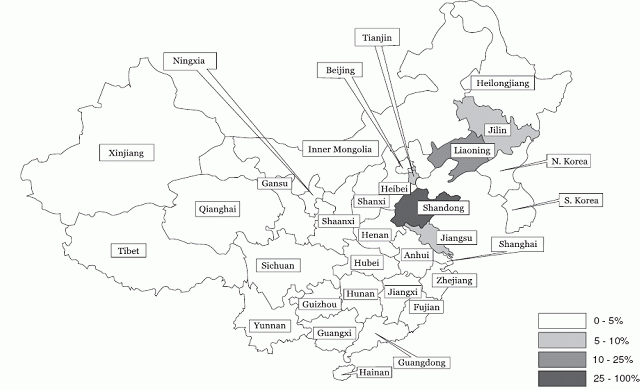Foreign direct investment has played a prominent role in the current wave of globalisation. The World Investment Report (UNCTAD, 2008) notes that total worldwide FDI flows in 2007 amounted to 1.8 trillion dollars. More than 25% of these flows were to developing economies. China has received a major part of these FDI flows, and it has also been very active in trying to attract multinationals with export processing zones and tax incentives. It is no surprise then, that policymakers are eager to better understand the driving forces behind multinational relocation decisions.
The ongoing and widespread reorganisation of firms’ production across borders has revealed key factors behind multinationals’ location decisions. Multinationals venture abroad because lower wages enable them to produce at lower cost; because they want to be close to the customer and avoid transportation costs or tariffs; or because they want to take advantage of differences in tax treatment. It is increasingly clear that these traditional factors do not exhaustively explain why multinationals pick a particular destination (Blonigen 2005).
Agglomeration
It has been observed that investors cluster together. Foreign investors are more likely to set up an affiliate where there are other firms. In itself, this may not be too much of a surprise. Alfred Marshall long ago pointed out that externalities can rationalise the agglomeration of firms. Clustering may produce knowledge and technology spillovers between firms, increase the availability of specialised labour from which new entrants can hire, and build up a pool of specialised inputs in a particular location as well. Needless to say, these by-products of clustering motivate local and national authorities to try to attract FDI.
Interestingly, however, foreign investments tend to agglomerate around investments from the same country of origin. And this poses a challenge. Why do multinationals from the same country cluster together? In a recent study, we investigate the agglomeration of South Korean multinationals in China (Debaere, Lee, and Paik 2008).
South Korean FDI in China
South Korea has taken advantage of the increasingly open Chinese borders especially since it established diplomatic relations with China in 1992. We employ the entire sample of South Korea’s individual investment decisions into China’s regions since 1988. As Figure 1 suggests, the regional distribution of South Korean multinationals in China is uneven, and concentrated in a few provinces that are geographically close to South Korea. Controlling for the characteristics of individual provinces (including their proximity to South Korea) with province fixed effects and controlling for year-specific effects, we find, however, that the presence of other South Korean affiliates in a Chinese province still plays a significant role in explaining the location decision of South Korea’s multinationals. This finding is consistent with the existing literature. The challenge is to unravel some of the reasons behind the regional clustering along national lines.
Figure 1 Distribution of South Korean investment in China
Source: Export-Import Bank of Korea
To further analyse clustering, we focus on backward and forward linkages with other South Korean affiliates and with other firms in China’s provinces. Earlier work by Amiti and Javorcik (2008) has shown the importance of linkages in firms’ location decisions – the extent to which there are potential downstream customers for a firm’s products makes a location more attractive, as does the presence of upstream suppliers. We explicitly investigate the strength of these regional linkages along national lines and find a strong orientation of South Korean firms towards their South Korean peer suppliers and customers. In particular, we find that backward and forward linkages with other South Korean firms are more important than backward and forward linkages per se.
Policy consequences
Our analysis shows that the presence of export zones is an important factor in attracting multinationals from South Korea, as it is for multinationals from other nationalities. However, the importance of clustering along national lines due to backward and forward linkages with firms from the same home country suggests that there may be potential benefits from targeting companies from those countries whose multinationals are already present in the region. At the same time, however, our results qualify the types of benefits that policy makers may expect as they try to attract foreign multinationals. The fact that linkages along national lines matter suggests that potential spillover gains are internalised by the affiliates of a particular country. Hence, attracting foreign firms, say, to have one’s own domestic firms benefit may be a lot harder to achieve.1
References
Amiti, Mary and Beata Javorcik, 2008, Trade Costs and Location of Foreign Firms in China, Journal of Development Economics, 85, p. 129-149.
Blonigen, Bruce, 2005, A Review of the Empirical Literature on FDI Determinants, NBER Working Paper 11299.
Debaere, Peter, Joon Lee and Myungho Paik, 2008, Agglomeration, Backward and Forward linkages: Evidence from South Korean Investment in China, CEPR Discussion Paper 7079.
Girma, Sourafel, Yundan Gong and Holger Goerg, 2008, Foreign Direct Investment, Access to Finance, and Innovation Activity in Chinese Enterprises, World Bank Economic Review, 220, 367-382.
1 This finding is consistent with Girma, Gong and Goerg (2008) who find limited spillovers from FDI in China on its domestic state-owned enterprises.






